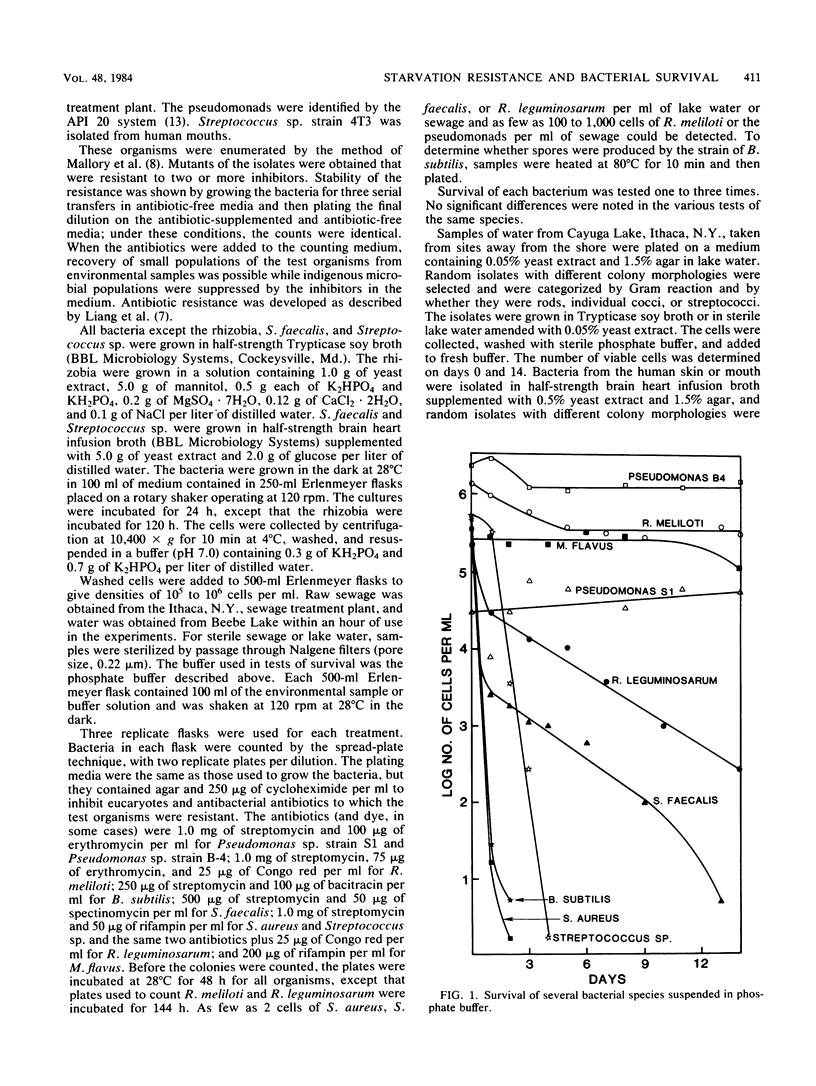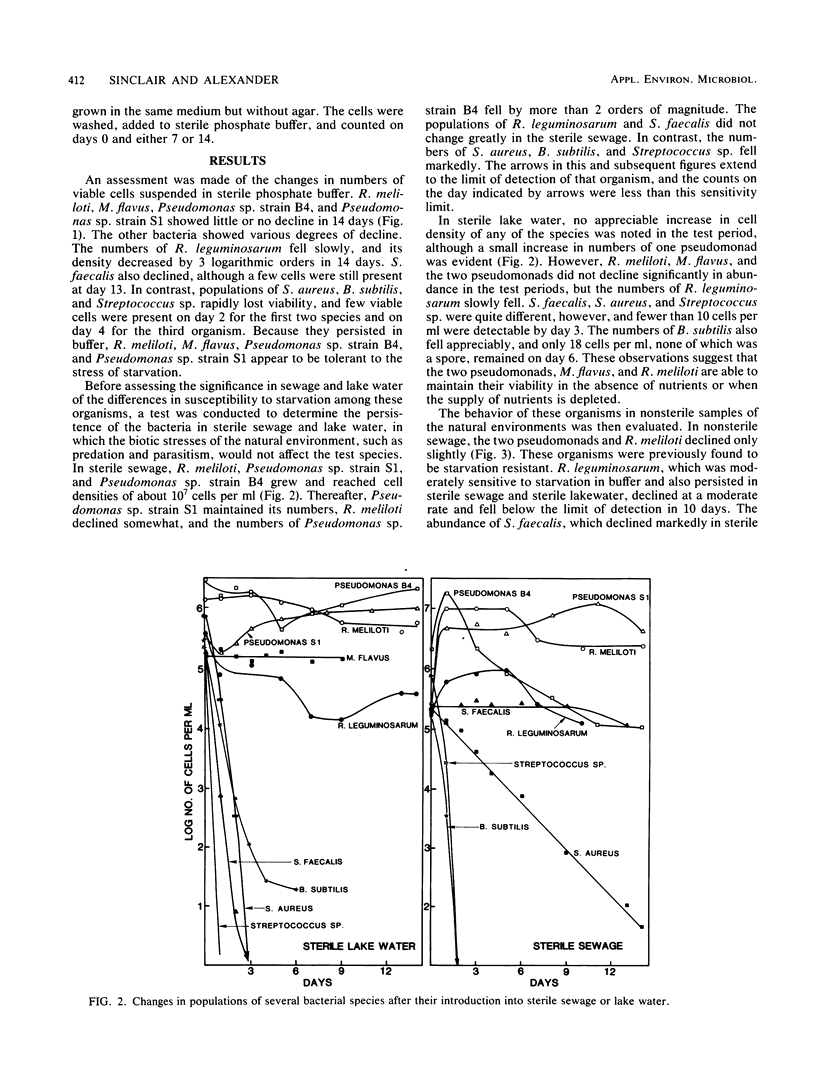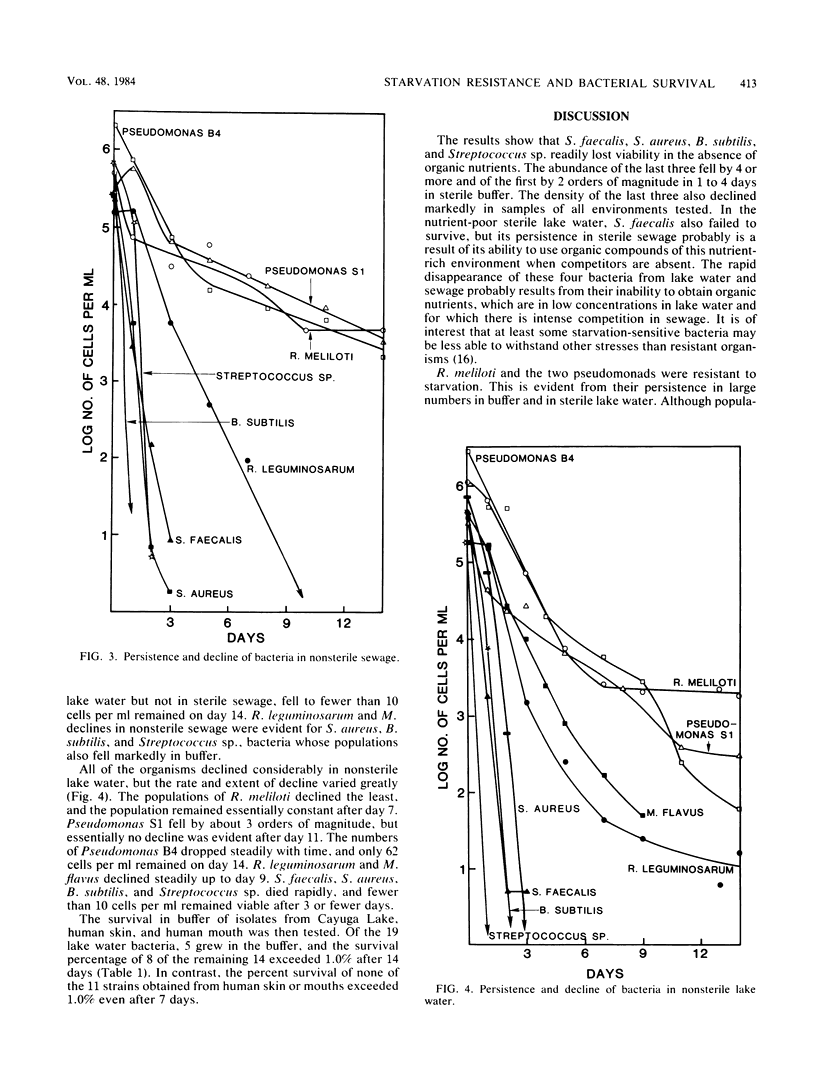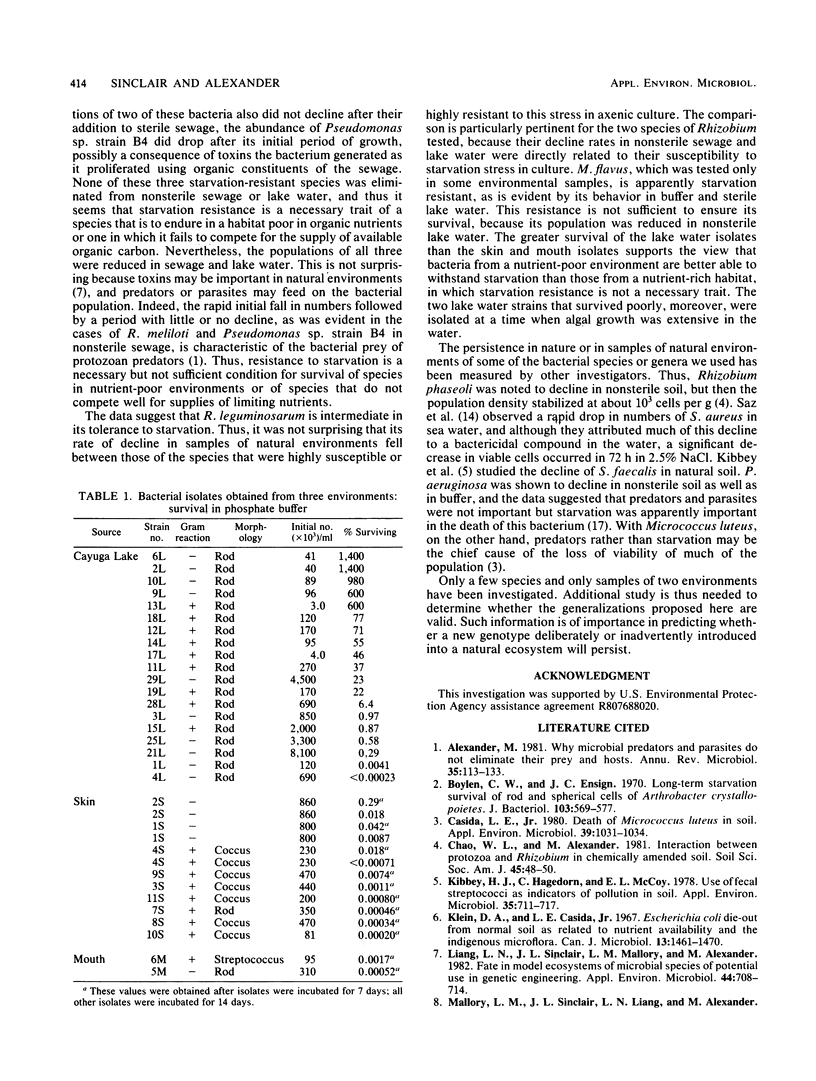Abstract
A study was conducted to determine the significance of starvation resistance to the ability of a species to survive in sewage and lake water. Tests were conducted for periods of up to 14 days. Rhizobium meliloti and one fluorescent and one nonfluorescent strain of Pseudomonas were resistant to starvation because their population sizes did not fall appreciably in buffer and sterile lake water, and the first two maintained high numbers after being added to sterile sewage. Cell densities of these bacterial species dropped slowly in nonsterile sewage, and more cells of these three organisms than of the other test organisms remained in nonsterile lake water. Rhizobium leguminosarum was moderately resistant to starvation because its numbers fell slowly in buffer and sterile lake water and did not change appreciably in sterile sewage. The abundance of Micrococcus flavus added to buffer and sterile lake water did not change, but the density of M. flavus declined in nonsterile lake water. The abundance of R. leguminosarum fell in nonsterile lake water and nonsterile sewage. Streptococcus faecalis, Staphylococcus aureus, an asporogenous strain of Bacillus subtilis, and Streptococcus sp. were susceptible to starvation because their populations were markedly reduced in buffer. Populations of the last three species declined rapidly in nonsterile and sterile samples of lake water and sewage. S. faecalis declined rapidly when added to nonsterile lake water and sewage and sterile lake water but not when added to sterile sewage, the persistence in the last instance probably being associated with the availability of organic nutrients.(ABSTRACT TRUNCATED AT 250 WORDS)
Full text
PDF





Selected References
These references are in PubMed. This may not be the complete list of references from this article.
- Alexander M. Why microbial predators and parasites do not eliminate their prey and hosts. Annu Rev Microbiol. 1981;35:113–133. doi: 10.1146/annurev.mi.35.100181.000553. [DOI] [PubMed] [Google Scholar]
- Casida L. E. Death of Micrococcus luteus in Soil. Appl Environ Microbiol. 1980 May;39(5):1031–1034. doi: 10.1128/aem.39.5.1031-1034.1980. [DOI] [PMC free article] [PubMed] [Google Scholar]
- Ensign J. C. Long-term starvation survival of rod and spherical cells of Arthrobacter crystallopoietes. J Bacteriol. 1970 Sep;103(3):569–577. doi: 10.1128/jb.103.3.569-577.1970. [DOI] [PMC free article] [PubMed] [Google Scholar]
- Kibbey H. J., Hagedorn C., McCoy E. L. Use of fecal streptococci as indicators of pollution in soil. Appl Environ Microbiol. 1978 Apr;35(4):711–717. doi: 10.1128/aem.35.4.711-717.1978. [DOI] [PMC free article] [PubMed] [Google Scholar]
- Klein D. A., Casida L. E., Jr Escherichia coli die-out from normal soil as related to nutrient availability and the indigenous microflora. Can J Microbiol. 1967 Nov;13(11):1461–1470. doi: 10.1139/m67-194. [DOI] [PubMed] [Google Scholar]
- Liang L. N., Sinclair J. L., Mallory L. M., Alexander M. Fate in model ecosystems of microbial species of potential use in genetic engineering. Appl Environ Microbiol. 1982 Sep;44(3):708–714. doi: 10.1128/aem.44.3.708-714.1982. [DOI] [PMC free article] [PubMed] [Google Scholar]
- Nelson L. M., Parkinson D. Effect of starvation on survival of three bacterial isolates from an arctic soil. Can J Microbiol. 1978 Dec;24(12):1460–1467. doi: 10.1139/m78-235. [DOI] [PubMed] [Google Scholar]
- Novitsky J. A., Morita R. Y. Survival of a psychrophilic marine Vibrio under long-term nutrient starvation. Appl Environ Microbiol. 1977 Mar;33(3):635–641. doi: 10.1128/aem.33.3.635-641.1977. [DOI] [PMC free article] [PubMed] [Google Scholar]
- POSTGATE J. R., HUNTER J. R. The survival of starved bacteria. J Gen Microbiol. 1962 Oct;29:233–263. doi: 10.1099/00221287-29-2-233. [DOI] [PubMed] [Google Scholar]
- Robertson E. A., MacLowry J. D. Mathematical analysis of the API enteric 20 profile register using a computer diagnostic model. Appl Microbiol. 1974 Oct;28(4):691–695. doi: 10.1128/am.28.4.691-695.1974. [DOI] [PMC free article] [PubMed] [Google Scholar]
- Strange R. E. Bacterial "glycogen" and survival. Nature. 1968 Nov 9;220(5167):606–607. doi: 10.1038/220606a0. [DOI] [PubMed] [Google Scholar]
- Wu S. Y., Klein D. A. Starvation effects on Escherichia coli and aquatic bacterial responses to nutrient addition and secondary warming stresses. Appl Environ Microbiol. 1976 Feb;31(2):216–220. doi: 10.1128/aem.31.2.216-220.1976. [DOI] [PMC free article] [PubMed] [Google Scholar]
- Zechman J. M., Casida L. E., Jr Death of Pseudomonas aeruginosa in soil. Can J Microbiol. 1982 Jul;28(7):788–794. doi: 10.1139/m82-120. [DOI] [PubMed] [Google Scholar]


